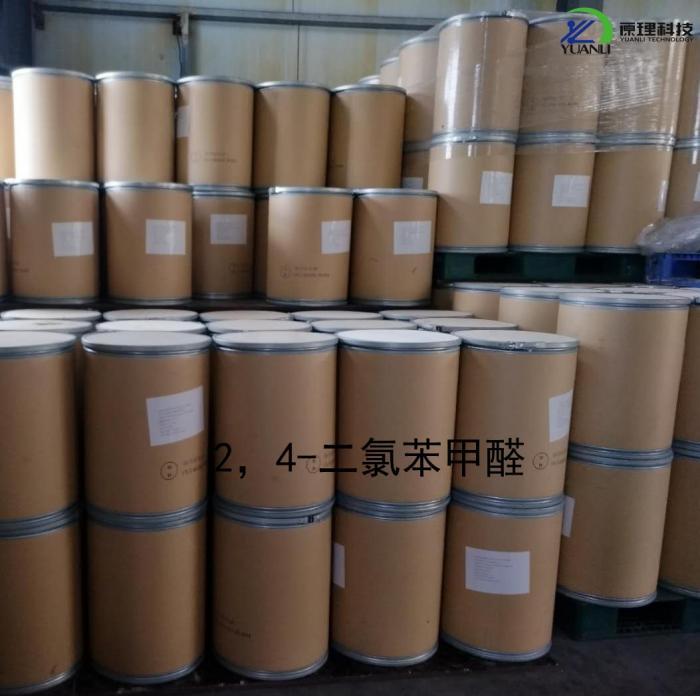2,4-Dichlorobenzaldehyde
Properties
Synonym: 2,4-Dichlorobenzaldehyde
| Product Name | 2,4-Dichlorobenzaldehyde |
| CAS NO. | 874-42-0 |
| Molecular Formula | C7H4Cl2O |
| Molecular Weight | 175.01 |
| Appearance | White to light yellow flake solid |
Specification
| Assay | 99% |
| Melting Point | 69~73℃ |
| Boiling Point | 233℃ |
| Package | 40kg/Drum |
Usage
Pharmaceutical intermediates; Pesticide IntermediateDescription
99% 2,4-Dichlorobenzaldehyde; 2,4-Dichlorobenzaldehyde supplier
Chemical properties 2,4-Dichlorobenzaldehyde is a white solid, m.p.69~73℃, b.p.233℃, hardly soluble in water, easily soluble in organic solvents such as alcohol, ether, ketone, acetic acid and benzene. Uses 2,4-Dichlorobenzaldehyde is an intermediate of the bactericide diniconazole. Use as dye intermediate. This product can be made into benzaldehyde-2,4-disulfonic acid [88-39-1] under the action of sodium bisulfite. Benzaldehyde-2,4-disulfonic acid is a dye intermediate for synthesis Reactive dark blue K-FGR and acid lake blue A, benzaldehyde-2,4-disulfonic acid can also be prepared by sulfonating and oxidizing toluene. 2,4-Dichlorobenzaldehyde is also used in the synthesis of diniconazole, which is a new type of pesticide that replaces fenpropanin. Uses Used as intermediates for pesticides and dyes. It is an important intermediate for the synthesis of diniconazole, a fungicide. The production method is derived from the chlorination of benzaldehyde in the presence of iodine or antimony. Production method: The preparation method is to hydrolyze 2,4-dichlorobenzylidene dichloride obtained by side chain chlorination of 2,4-dichlorotoluene under illumination to obtain 2,4-dichlorobenzaldehyde. Add 2,4-dichlorotoluene and catalyst PCl3 (approximately 1% of the mass of 2,4-dichlorotoluene) into the Chemicalbook of the chlorination reactor, heat to 120°C, and pass chlorine gas under light conditions to react , When the conversion rate of 2,4-dichlorotoluene is ≥99% after sampling and analysis by GC, it is the end point of the chlorination reaction, and the chlorinated product, 2,4-dichlorobenzyl chloride 0.62%, 2,4-dichloro Benzylidene dichloride 85.18%, α,α,α-trichloro-2,4-dichlorotoluene 13.83%. The yield of 2,4-dichlorobenzylidene dichloride reached 87.1%. Add the crude 2,4-dichlorobenzylidene dichloride and the catalyst metal oxide into the hydrolysis kettle, heat it to 100°C, add an appropriate amount of water dropwise to carry out the hydrolysis reaction, take a sample for about 3.5 hours and analyze it by GC. 2,4 The conversion rate of dichlorobenzylidene dichloride>99% is the end point of the hydrolysis reaction. Let stand for several hours to separate the water layer. Wash the oil layer with 10% NaCO and neutralize it to alkalinity. Separate the aldehyde and acid from the hydrolysis. Crude aldehyde After distillation, 2,4-dichlorobenzaldehyde was obtained. At present, the new process for the synthesis of 2,4-dichlorobenzaldehyde adopts the pentadione method, that is, pentadione is cyclized in the presence of DME and POCl3 to obtain 2,4-dichlorobenzaldehyde, and the yield of the one-step process is 65%. ~75%, but further research is needed for industrialization.
